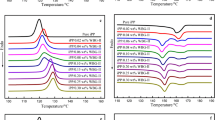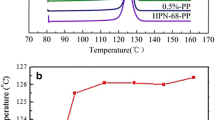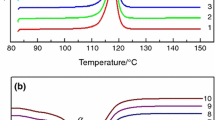Abstract
Nine nucleating agents, calcium pimelate (CaPi), bicyclic [1, 2, 2]heptane di-carboxylate (HPN-68), a commercially obtained aryl amide nucleating agent (TMB-5), calcium salt of hexahydrophthalic acid (HPN-20E), 1,3:2,4-di-p-methylbenzylidene sorbitol (MDBS) and sodium, potassium, magnesium and calcium salt of benzene-1, 3, 5-tricarboxylic acid (Na3BTC, K3BTC, Mg3BTC2 and Ca3BTC2, respectively), were applied to reduce the supercooling of erythritol, and their effects were investigated by cyclic differential scanning calorimetry (DSC). The results revealed that Na3BTC and K3BTC could not induce erythritol to crystallize under the experiment condition. MDBS could only make erythritol to crystallize at a temperature slightly higher than that of pure erythritol, and the effect was unstable. Mg3BTC2, Ca3BTC2 and HPN-68 could induce erythritol to crystallize at relatively high temperature, but the peak temperature of crystallizing (T p, cr) and the phase change enthalpy of crystallizing (Δcr H) decreased greatly as the melting–crystallizing cycles increased. HPN-20E-doped erythritol crystallized at a high temperature with the T p, cr of 69.3 °C at the first cycle, but the T p, cr and Δcr H varied greatly during the melting–crystallizing cycles. CaPi and TMB-5 could induce erythritol to crystallize at a stable temperature with the T p, cr of about 69 °C and 64 °C, respectively, and with a stable Δcr H of about 204 and 185 J g−1, respectively, in all melting–crystallizing cycles. Hence, CaPi- and TMB-5-doped erythritol could be used as PCMs and applied in thermal energy storage in which the energy was absorbed at a high temperature and released at a lower but stable temperature.








Similar content being viewed by others
References
Barlev D, Vidu R, Stroeve P. Innovation in concentrated solar power. Sol Energy Mater Sol Cells. 2011;95(10):2703–25.
Aman MM, Solangi KH, Hossain MS, Badarudin A, Jasmon GB, Mokhlis H, et al. A review of safety, health and environmental (SHE) issues of solar energy system. Renew Sustain Energy Rev. 2015;41:1190–204. doi:10.1016/j.rser.2014.08.086.
Su W, Darkwa J, Kokogiannakis G. Review of solid–liquid phase change materials and their encapsulation technologies. Renew Sustain Energy Rev. 2015;48:373–91. doi:10.1016/j.rser.2015.04.044.
Pintaldi S, Perfumo C, Sethuvenkatraman S, White S, Rosengarten G. A review of thermal energy storage technologies and control approaches for solar cooling. Renew Sustain Energy Rev. 2015;41:975–95. doi:10.1016/j.rser.2014.08.062.
Khadiran T, Hussein MZ, Zainal Z, Rusli R. Encapsulation techniques for organic phase change materials as thermal energy storage medium: a review. Sol Energy Mater Sol Cells. 2015;143:78–98. doi:10.1016/j.solmat.2015.06.039.
Z-j Duan, H-z Zhang, L-x Sun, Cao Z, Xu F, Y-j Zou, et al. CaCl2·6H2O/expanded graphite composite as form-stable phase change materials for thermal energy storage. J Therm Anal Calorim. 2014;115(1):111–7. doi:10.1007/s10973-013-3311-0.
Zhang HZ, Xu QY, Zhao ZM, Zhang J, Sun YJ, Sun LX, et al. Preparation and thermal performance of gypsum boards incorporated with microencapsulated phase change materials for thermal regulation. Sol Energy Mater Sol Cells. 2012;102:93–102. doi:10.1016/j.solmat.2012.03.020.
Zeng JL, Zheng SH, Yu SB, Zhu FR, Gan J, Zhu L, et al. Preparation and thermal properties of palmitic acid/polyaniline/exfoliated graphite nanoplatelets form-stable phase change materials. Appl Energy. 2014;115:603–9. doi:10.1016/j.apenergy.2013.10.061.
Zeng JL, Gan J, Zhu FR, Yu SB, Xiao ZL, Yan WP, et al. Tetradecanol/expanded graphite composite form-stable phase change material for thermal energy storage. Sol Energy Mater Sol Cells. 2014;127:122–8. doi:10.1016/j.solmat.2014.04.015.
Fernández AG, Galleguillos H, Fuentealba E, Pérez FJ. Thermal characterization of HITEC molten salt for energy storage in solar linear concentrated technology. J Therm Anal Calorim. 2015;122(1):3–9. doi:10.1007/s10973-015-4715-9.
Genc ZK, Canbay CA, Acar SS, Sekerci M, Genc M. Preparation and thermal properties of heterogeneous composite phase change materials based on camphene–palmitic acid. J Therm Anal Calorim. 2015;120(3):1679–88. doi:10.1007/s10973-015-4478-3.
Sádovská G, Honcová P, Pilař R, Oravová L, Honc D. Calorimetric study of calcium nitrate tetrahydrate and magnesium nitrate hexahydrate. J Therm Anal Calorim. 2016;124(1):539–46. doi:10.1007/s10973-015-5159-y.
Hidaka H, Yamazaki M, Yabe M, Kakiuchi H, Ona EP, Kojima Y, et al. New PCMs prepared from erythritol–polyalcohols mixtures for latent heat storage between 80 and 100 °C. J Chem Eng Jpn. 2004;37(9):1155–62. doi:10.1252/jcej.37.1155.
Adachi T, Daudah D, Tanaka G. Effects of supercooling degree and specimen size on supercooling duration of erythritol. ISIJ Int. 2014;54(12):2790–5. doi:10.2355/isijinternational.54.2790.
Ona EP, Zhang X, Kyaw K, Watanabe F, Matsuda H, Kakiuchi H, et al. Relaxation of supercooling of erythritol for latent heat storage. J Chem Eng Jpn. 2001;34(3):376–82. doi:10.1252/jcej.34.376.
Okawa S, Saito A, Minami R. The solidification phenomenon of the supercooled water containing solid particles. Int J Refrig. 2001;24(1):108–17. doi:10.1016/S0140-7007(00)00060-8.
Ona EP, Zhang X, Ozawa S, Matsuda H, Kakiuchi H, Yabe M, et al. Influence of ultrasonic irradiation on the solidification behavior of erythritol as a PCM. J Chem Eng Jpn. 2002;35(3):290–8. doi:10.1252/jcej.35.290.
Wei L, Ohsasa K. Supercooling and solidification behavior of phase change material. ISIJ Int. 2010;50(9):1265–9. doi:10.2355/isijinternational.50.1265.
Kholmanov I, Kim J, Ou E, Ruoff RS, Shi L. Continuous carbon nanotube-ultrathin graphite hybrid foams for increased thermal conductivity and suppressed subcooling in composite phase change materials. ACS Nano. 2015;9(12):11699–707. doi:10.1021/acsnano.5b02917.
Ushak S, Gutierrez A, Barreneche C, Fernandez AI, Grágeda M, Cabeza LF. Reduction of the subcooling of bischofite with the use of nucleatings agents. Solar Energy Mater Sol Cells. 2016;157:1011–8. doi:10.1016/j.solmat.2016.08.015.
Cui W, Yuan Y, Sun L, Cao X, Yang X. Experimental studies on the supercooling and melting/freezing characteristics of nano-copper/sodium acetate trihydrate composite phase change materials. Renew Energy. 2016;99:1029–37. doi:10.1016/j.renene.2016.08.001.
Safari A, Saidur R, Sulaiman FA, Xu Y, Dong J. A review on supercooling of phase change materials in thermal energy storage systems. Renew Sustain Energy Rev. 2017;70:905–19. doi:10.1016/j.rser.2016.11.272.
Al-Shannaq R, Kurdi J, Al-Muhtaseb S, Dickinson M, Farid M. Supercooling elimination of phase change materials (PCMs) microcapsules. Energy. 2015;87:654–62. doi:10.1016/j.energy.2015.05.033.
Li JX, Cheung WL. Pimelic acid-based nucleating agents for hexagonal crystalline polypropylene. J Vinyl Addit Technol. 1997;3(2):151–6. doi:10.1002/vnl.10182.
Zhang YF, Chang Y, Li X, Xie D. Nucleation effects of a novel nucleating agent bicyclic [1, 2, 2] heptane di-carboxylate in isotactic polypropylene. J Macromol Sci B. 2010;50(2):266–74. doi:10.1080/00222341003648995.
Liu H, Huo H. Crystal phases, structure, and orientation in isotactic polypropylene after isothermal crystallization under oscillatory shear as a function of nucleation agent. Colloid Polym Sci. 2014;292(4):849–61. doi:10.1007/s00396-013-3133-4.
Zhang YF, Guo LH, Chen H, Liu BB, Gu YH. Properties and crystallization behaviors of isotactic polypropylene under action of an effective nucleating agent. J Macromol Sci B. 2015;54(9):1019–28. doi:10.1080/00222348.2015.1060404.
Zhang YF. Comparison of nucleation effects of organic phosphorous and sorbitol derivative nucleating agents in isotactic polypropylene. J Macromol Sci B. 2008;47(6):1188–96. doi:10.1080/00222340802403412.
Zhang YF, Luo XZ. Effects of benzene-1, 3, 5-tricarboxylate salts on crystallization and melting behaviors of isotactic polypropylene. In: Prushotaman E, editor. 2013 international conference on biological, medical and chemical engineering. Hong Kong; 2013.
Ceccarelli C, Jeffrey GA, McMullan RK. A neutron diffraction refinement of the crystal structure of erythritol at 22.6 K. Acta Crystallogr B. 1980;36(12):3079–307983. doi:10.1107/S0567740880010825.
Lopes Jesus AJ, Nunes SCC, Ramos Silva M, Matos Beja A, Redinha JS. Erythritol: crystal growth from the melt. Int J Pharm. 2010;388(1–2):129–35. doi:10.1016/j.ijpharm.2009.12.043.
Domalski ES, Hearing ED. Heat capacities and entropies of organic compounds in the condensed phase. Volume III. J Phys Chem Ref Data. 1996;25(1):1–525. doi:10.1063/1.555985.
Zalba B, Marin JM, Cabeza LF, Mehling H. Review on thermal energy storage with phase change: materials, heat transfer analysis and applications. Appl Therm Eng. 2003;23(3):251–83.
Acknowledgements
The authors gratefully acknowledge the financial support from the National Natural Science Foundation of China (21003014, 21376031, 21501015 and 21275022), the Natural Science Foundation of Hunan Province, China (2017JJ1026, 13JJ3068), Scientific Research Fund of Hunan Provincial Education Department (15B0002) and the Hunan Provincial Key Laboratory of Materials Protection for Electric Power and Transportation (Changsha University of Science and Technology) (2014CL05).
Author information
Authors and Affiliations
Corresponding author
Rights and permissions
About this article
Cite this article
Zeng, JL., Zhou, L., Zhang, YF. et al. Effects of some nucleating agents on the supercooling of erythritol to be applied as phase change material. J Therm Anal Calorim 129, 1291–1299 (2017). https://doi.org/10.1007/s10973-017-6296-2
Received:
Accepted:
Published:
Issue Date:
DOI: https://doi.org/10.1007/s10973-017-6296-2




